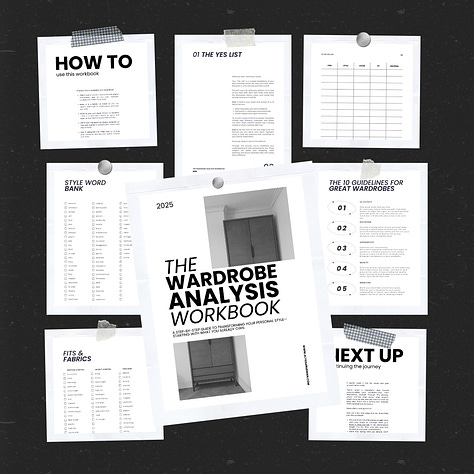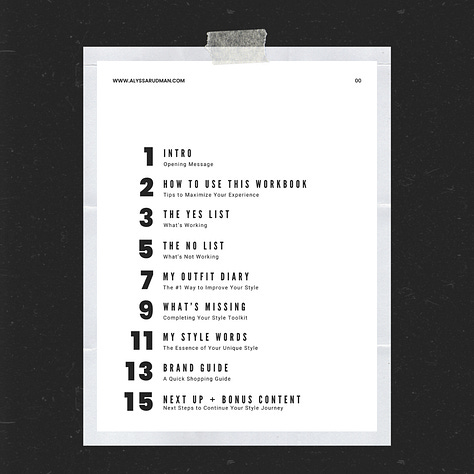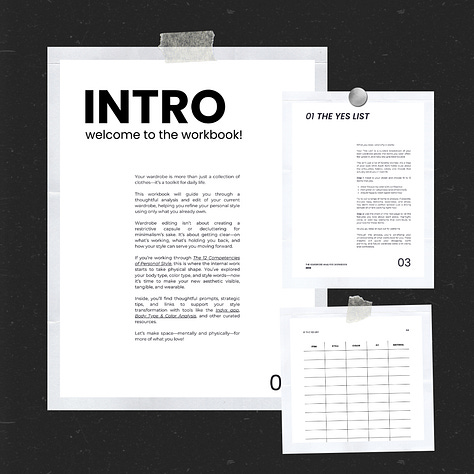Editing > Shopping
🧪 Entry #17: Cut the noise and actually start wearing what you love.
By now, you’ve been building a picture in your mind of your new aesthetic using your body type, color type, and Style Words.
You’re starting to get a clearer sense of what belongs in your wardrobe, and what doesn’t.
wardrobe editing
silhouette + proportion
color story
texture
multidimensional style
conflict + balance
full outfits
My Perspective on Wardrobe Editing
This next step isn’t about purging everything you haven’t worn in a year. We’re not here to Marie Condo or Fling Boogie1.
Instead, this is about removing the visual and emotional distractions that keep you from seeing (and wearing) the pieces that actually feel like you.
I see our wardrobes as growing collections. Functional personal archives that evolve over time. Some pieces are seasonal. Others are aspirational. Some come in and out of rotation, but still reflect your personality year after year.
So instead of asking, have I worn this lately? Ask yourself:
Does this align with my Style Words and personal aesthetic?
Do I see myself wearing this now, or in the future?
Is this piece a distraction, or a deliberate choice?
Editing your wardrobe is not about having less. It’s about making space for more of what you love.
🗝️ Behind the Paywall [UNLOCKED]
This entry is fully unlocked so you can see what’s normally behind the paywall. If you like what you see, come join us.
The exact 3-step process I use with clients to remove wardrobe distractions
What to do if you aren’t sure whether to keep or cull something
Access to the private thread: I’ll be hanging out and replying
You'll always receive the core lesson content as a free subscriber. Want all the exercises, bonus tools, and community access? Become a paid subscriber to get the full experience.
Exercise 5-1: Remove Distractions
This is not so much about getting rid of things as it is about getting clear on your style.
We’re going to uncover what’s truly serving you in your wardrobe, and what’s getting in the way.
Step 1: The Yes List
Pull 10–15 pieces from your wardrobe that you:
Wear frequently and with confidence
Feel great in (physically and emotionally)
Would happily wear again tomorrow
Aim for variety: tops, bottoms, outerwear, and shoes if possible.
Write down (or mentally note) what you love about each item: fit, fabric, color, silhouette, and the mood it gives you.
Watch for patterns. Through this process, you’re solidifying your understanding of what works best for you. These insights will guide your shopping, outfit planning, and future wardrobe edits with clarity and confidence.
Step 2: The No List
Now choose 10–15 pieces you:
Rarely or never wear
Feel uncomfortable or unsure in
Regret buying (or wouldn’t buy again today)
Identify why they miss the mark. Is it the fit? The color? The fabric? The vibe?
Try them on if needed to reassess. Again, look for patterns. These are your avoids when shopping or editing in the future.
Step 3: Sort What’s Left
Once you’ve identified the best and worst, tackle the in-between pieces.
Sort everything (including your “No List” items) into three action piles:
Let Go – Items you no longer want, need, or plan to wear again. Donate, sell, gift, or toss.
Save for Later – Seasonal items, strong Statements that need a break, or sentimental pieces worth archiving.
Tailor or Rework – Pieces you love but don’t wear because they need fit adjustments or style updates. If you keep them, commit to acting within the next month. Otherwise, they go into the “Let Go” pile.
Pro Tip: If you’re unsure about a piece, put it in temporary storage. Revisit it in 1–3 months. If you didn’t miss it, it’s probably safe to let it go.



Download the Workbook
To help you through this process, I’ve created a printable workbook you can use to track what’s working, what’s not, and what’s worth saving for later.
📝 Download Your Wardrobe Analysis Workbook
It’s designed to help you feel mentally and emotionally clearer, not more overwhelmed. And by the end, you’ll have a more focused wardrobe and a stronger sense of style direction.
Next, we’ll talk about how to organize what’s left so that your wardrobe becomes an invitation to creativity, not a source of decision fatigue.
P.S. You don’t have to make any big decisions today. Start by removing the distractions. Just placing them out of sight is often enough to help you see what’s truly working.
Continue to Entry #18 →
Until Next Time,
Alyssa
I was the unfortunate victim of many a Fling Boogie during my time as a teenager. This was a twice-yearly tradition in which my mother and grandmother would “declutter” our house, often tossing out artifacts of significant importance.

So useful. I love the workbook, thank you!
Loved the exercise! I built my list of “doubts” for now: not a “no”, but also not really a “yes”! And I could see some patterns on the tops: too soft necks (no edges), tops that can’t be tucked in, too wide cuffs. So interesting!